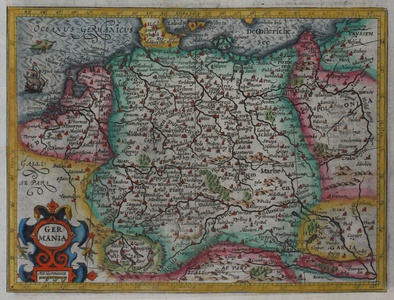| Method | Copper engraved with hand colour |
| Artist | Mercator, Gerard and Hondius, Jodocus |
| Published | [Imprinted at London for Henry Fetherston at ye signe of the rose in Pauls Churchyard, 1625] |
| Dimensions | 145 x 193 mm |
| Notes |
A map of Germany. Finely hand coloured and with a ship and huge fish included in the North Sea to the top left. Originally engraved by Jodocus Hondius for the Mercator-Hondius Atlas Minor, this particular example accompanied by English commentary and appearing in Samuel Purchas' Hakluytus Posthumus or Purchas his Pilgrimesthe. Hakluytus Posthumus or Purchas his Pilgrimes was a monumental four-volume collection of travellers reports and adventure stories, intended by the author, Samuel Purchas, as a continuation of the Principal Navigations of Richard Hakluyt, the British polymath and early supporter of British colonisation in the New World. At the time of publication in 1625, the Pilgrimes was the largest edition ever printed in England. In addition to the text, the book featured numerous maps, the majority of which had originally been engraved by Jodocus Hondius for inclusion in the Atlas Minor. The plates had been sold at auction by the Hondius publishing house in 1621 and purchased by an English publisher. For the Pilgrimes, Purchas simply reprinted the plates with English titles above. Gerard Mercator (1512 - 1594) originally a student of philosophy was one of the most renowned cosmographers and geographers of the 16th century, as well as an accomplished scientific instrument maker. He is most famous for introducing 'Mercators Projection', a system which allowed navigators to plot the same constant compass bearing on a flat map. His first maps were published in 1537 (Palestine), and 1538 (a map of the world), although his main occupation at this time was globe-making. He later moved to Duisburg, in Germany, where he produced his outstanding wall maps of Europe and of Britain. In 1569 he published his masterpiece, the twenty-one-sheet map of the world, constructed on Mercator's 'Projection'. His 'Atlas, sive Cosmographicae Meditationes de Fabrica Mundi', was completed by his son Rumold and published in 1595. After Rumold's death in 1599, the plates for the atlas were published by Gerard Jr. Following his death in 1604, the printing stock was bought at auction by Jodocus Hondius, and re-issued well into the seventeenth century. Jodocus Hondius (14th October 1563 - 12th February 1612) was a Dutch Flemish cartographer, engraver, and publisher. Hondius is most famous for reviving the primacy of the work of Gerard Mercator, through the publication of his Atlas, and the smaller Atlas Minor, in the early seventeenth century, at a time when cartography was largely dominated by Ortelius' 'Theatrum Orbis Terrarum'. The Mercator-Hondius Atlas was composed of maps pulled from plates Hondius had purchased from Mercator's grandson, as well as thirty-six new plates Hondius commissioned, and in many cases engraved, himself. He is also believed to have been the chief engraver of the plates for John Speed's 'Theatre of the Empire of Great Britaine'. Following his death, he was succeeded by his sons, Jodocus the Younger and Henricus, as well as his son in law Jan Jansson. Condition:Good strong hand colouring, re-margined at base. |
| Framing | unmounted |
| Price | £175.00 |
| Stock ID | 45721 |

